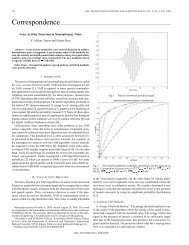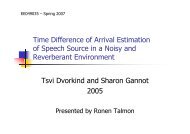Thesis (PDF) - Signal & Image Processing Lab
Thesis (PDF) - Signal & Image Processing Lab
Thesis (PDF) - Signal & Image Processing Lab
Create successful ePaper yourself
Turn your PDF publications into a flip-book with our unique Google optimized e-Paper software.
40 CHAPTER 3. IMPLEMENTATION OF BTVT<br />
3.3 Implementation of the BTV Transform<br />
The first phase of the algorithm is to create a Region Adjacency Graph - RAG. The<br />
RAG is a graph (V, E), where V is a set of all flat zones of the image, and E contains<br />
all pairs of flat zones that are adjacent to each other. A theoretical background on<br />
graphs and trees is given in section 2.1. We developed an algorithm for computing the<br />
RAG image representation. A pseudo code of the algorithm is given in Appendix A.<br />
The next step is to use the modified Moore algorithm for creation of a TD-Tree.<br />
The modification of the Moore algorithm was explained in section 3.1.<br />
In order to calculate an alternating sequence of every flat zone, we must fetch<br />
the path variation of a component. The path variation fetch function, is a recursive<br />
function, as can be seen in (3.1).<br />
AS(V ) =<br />
�<br />
{AS(father(V )), GL(V ) − GL(father(V ))} if V �= root<br />
{0} if V = root<br />
(3.1)<br />
Where AS(V ) is an alternating sequence of vertex V in the TD-tree. GL(V ) is the<br />
gray level of V . father(V ) is the vertex preceding V in the TD-tree. For example,<br />
AS(V2) in Fig. 3.1 gives an alternating sequence of {AS(V1), −3} in the first recursion<br />
step, and {5, −3} in the next (and last) recursion step.<br />
The alternating sequence computation can be performed as a preliminary step<br />
before any operators are applied, or during an execution of an operator. The choice<br />
between the two options depends on a specific tradeoff between storage size and<br />
execution time.<br />
In summary, the proposed algorithm for the implementation of the BTV transform<br />
consists of three stages:<br />
1. The input image is represented as a Regional Adjacency Graph (RAG) of the<br />
flat zones partition.<br />
2. Based on this RAG representation, the topographic distance is calculated and<br />
the TD-Tree is obtained, using the modified Moore algorithm.<br />
3. The BTV transform is calculated, using the TD-Tree.<br />
<strong>Image</strong>s of topographic distances, computed for synthetic and natural images, using<br />
the modified Moore algorithm, are shown in Figures 3.2-3.5. The images are built
















